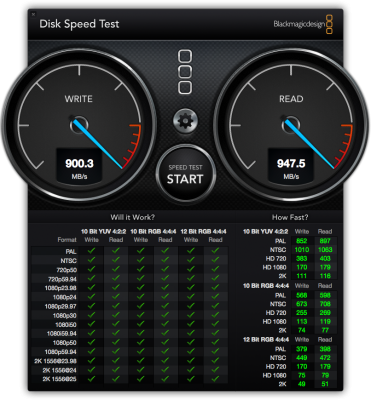- Joined
- Oct 4, 2011
- Messages
- 37
- Motherboard
- GA-X99-UD4
- CPU
- i7-5930k
- Graphics
- Nvidia GTX980 SLi
- Mac
- Classic Mac
- Mobile Phone
We're talking software RAID right?
We're talking software RAID right?
Also, here is an attached copy of my Blackmagic results:
View attachment 120325

alias efi='diskutil mount 79635BDD-02F2-46C4-9DCD-876CD925EC5B'/dev/disk0
#: TYPE NAME SIZE IDENTIFIER
0: GUID_partition_scheme *1.0 TB disk0
1: EFI EFI 209.7 MB disk0s1
2: Apple_RAID 200.0 GB disk0s2
3: Apple_Boot Boot OS X 134.2 MB disk0s3
4: Apple_HFS Storage 799.7 GB disk0s4
/dev/disk1
#: TYPE NAME SIZE IDENTIFIER
0: GUID_partition_scheme *1.0 TB disk1
1: EFI EFI 209.7 MB disk1s1
2: Apple_RAID 200.0 GB disk1s2
3: Apple_Boot Boot OS X 134.2 MB disk1s3
4: Microsoft Basic Data Windows 8.1 799.9 GB disk1s4AppleRAID sets (1 found)
===============================================================================
Name: OS X
Unique ID: 1A47ABAB-FA4C-4AEB-9EC6-711FA476A5E4
Type: Stripe
Status: Online
Size: 400.0 GB (399999762432 Bytes)
Rebuild: manual
Device Node: disk2
-------------------------------------------------------------------------------
# DevNode UUID Status Size
-------------------------------------------------------------------------------
0 disk0s2 E2BE8856-F4BD-4AFF-83DF-6C0A117DA24B Online 199999881216
1 disk1s2 20D52CD0-34B7-4307-8BCA-10DDF46A658A Online 199999881216
===============================================================================efi partitions already exist from formatting the drives guid/Mac OSSo lets see if i have this correct.
1.
install clover on a drive.
2.
make a raid set with disk utility.
3.
clone my working drive to the Raid 0 set.
4.
make a efi (fat 32) partition on both drives of the raid 0 set.
5. install clover on both efi partition of the raid 0 set.
then it should be bootable?
| Size | Samsung Evo 840 SATA SSD - 1 TB | Samsung Evo 840 mSATA SSD - 1TB | Notes |
| 200 MB | EFI Empty FAT | EFI Clover installation & bootwmgr.efi for Windows FAT | Created automatically by OS X |
| 200 GB | OS X - RAID 0 Partition 1 HFS+ | OS - RAID 0 Partition 2 HFS+ | Created through Disk utility RAID across partitions RAID 0, total size 400 GB across 2 drives |
| 800 GB | Windows 8.1 NTFS | Storage HFS+ | Normal data partitions |
[FONT=Menlo]/dev/disk0[/FONT]
[FONT=Menlo] #: TYPE NAME SIZE IDENTIFIER[/FONT]
[FONT=Menlo] 0: GUID_partition_scheme *512.1 GB disk0[/FONT]
[FONT=Menlo] 1: EFI EFI 209.7 MB disk0s1[/FONT]
[FONT=Menlo] 2: Apple_RAID 60.0 GB disk0s2[/FONT]
[FONT=Menlo] 3: Apple_Boot Boot OS X 134.2 MB disk0s3[/FONT]
[FONT=Menlo] 4: Microsoft Reserved 134.2 MB disk0s4[/FONT]
[FONT=Menlo] 5: Microsoft Basic Data Windows 64.4 GB disk0s5[/FONT]
[FONT=Menlo] 6: Microsoft Basic Data Master 387.2 GB disk0s6[/FONT]
[FONT=Menlo]/dev/disk1[/FONT]
[FONT=Menlo] #: TYPE NAME SIZE IDENTIFIER[/FONT]
[FONT=Menlo] 0: GUID_partition_scheme *256.1 GB disk1[/FONT]
[FONT=Menlo] 1: EFI EFI 209.7 MB disk1s1[/FONT]
[FONT=Menlo] 2: Apple_RAID 60.0 GB disk1s2[/FONT]
[FONT=Menlo] 3: Apple_Boot Boot OS X 134.2 MB disk1s3[/FONT]
[FONT=Menlo] 4: Apple_HFS MacStorage 128.8 GB disk1s4[/FONT]
[FONT=Menlo] 5: Microsoft Basic Data Backup 66.9 GB disk1s5[/FONT]
[FONT=Menlo]/dev/disk2[/FONT]
[FONT=Menlo] #: TYPE NAME SIZE IDENTIFIER[/FONT]
[FONT=Menlo] 0: Apple_HFS OSX_Raid *120.0 GB disk2[/FONT]
I remember Windows not wanting to install on the disk.It will say it's not a GPT disk.
I used Linux and gpt to rewrite the partition from protective MBR to full GPT.
After that Windows installed fine.
